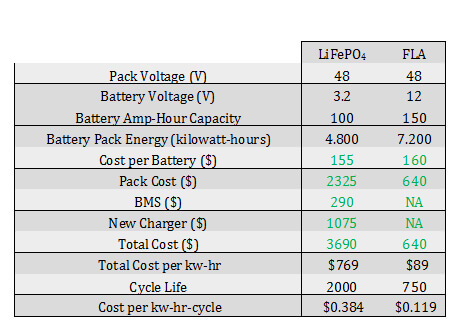
- China
- English
- Françai
- Español
- Deutsch
- Română
- العربية
- 한국어
- 日本語
- Italiano
- Português
- Gaeilge
- Dansk
- Čeština
- Русский
- Afrikaans
- Euskara
- Català
- Esperanto
- हिन्दी
- Ελληνικά
- Bahasa Melayu
- Polski
- Српски
- Kiswahili
- ภาษาไทย
- Tiếng Việt
- Türkçe
- Svenska
- Cymraeg
- Slovenčina
- Latviešu
- Malti
- Magyar
- Galego
- ગુજરાતી
- Eesti Keel
- বাংলা
- Shqip
- беларуская мова
- Nederlands
- Tagalog
- ქართული
- Íslenska
- Kreyòl Ayisyen
- Lietuvių
- Norsk
- slovenščina
- தமிழ்
- Українська
- ײִדיש
- اردو
- తెలుగు
- فارسی
- македонски
- ಕನ್ನಡ
- Bahasa Indonesia
- עברית
- Suomi
- Hrvatski
- Български
- Azerbaijani

Industry Application
Product Type
Lithium ion Golf Cart Batteries vs. Lead-Acid

The golf cart battery industry is in a state of flux. On one hand we have golf cart manufacturers and retailers that realize lithium-ion batteries are better for electric golf cart performance and longevity than lead acid batteries. On the other hand are consumers who resist the high upfront cost of Lithium ion Golf Cart Batteries, and consequently still rely on inferior lead-acid battery options. With operational costs being a major concern for anyone with a golf car fleet, it’s important to point out that there is the initial cost of a lithium iron phosphate pack (LiFePO4), plus the required additional equipment necessary to operate it. A single LiFePO4 cell has a nominal voltage of 3.2 volts, thus requiring 15 cells in series for a 48-volt deep cycle battery pack. The average retail price of one 100 Ah (amp-hour) cell is $155, putting the pack cost at $2325. A compatible BMS and charger cost $290 and $1075 respectively. Altogether, a conversion would cost $3690 and will provide a reported 2000 cycles at a lower energy content of 4800 watt-hours vs 7200 watt-hours for a comparable flooded lead-acid battery pack. When comparing the costs, (see the chart below) you can see that for a 48-volt pack, you can buy four 12-volt lead-acid batteries for about $640 retail. That will get you around 150 Ah and 750 or more cycles with no additional equipment needed. Overall, the flooded lead-acid battery pack will deliver more energy per cycle at a lower cost per kilowatt-hour on each cycle by a factor of over 3:1.
Wisdom Power supplies lithium and AGM lead-acid batteries type of golf cart battery, and we firmly believe Lithium ion Golf Cart Batteries are the best option for manufacturers, retailers and consumers alike. Consumer buying trends support our position. In December 2018, Germany golf cart manufacturers announced that nearly 70 percent of their carts and electronic golf accessories sold in Germany now containing lithium batteries. Unlike the rest of Europe, which already overwhelmingly adopted Lithium ion Golf Cart Batteries, the Germany. has been slower to make the change. When consumers—like those in Germany.—begin to understand the advantages lithium batteries provide compared to lead acid, we believe more people will demand their golf carts run on lithium power battery technology.
Below is our breakdown of golf cart battery. We compare the pros and cons of lithium and lead-acid ggolf cart battery and discuss why we feel lithium-ion batteries are a superior choice. Carrying Capacity Equipping a lithium-ion battery into a golf cart enables the cart to significantly increase its weight-to-performance ratio. Lithium ion Golf Cart Batteries are half the size of a traditional lead-acid battery, which shaves off two-thirds of the battery weight a golf cart would normally operate with. The lighter weight means the golf cart can reach higher speeds with less effort and carry more weight without feeling sluggish to the occupants. The weight-to-performance ratio difference lets the lithium-powered cart carry an additional two average-sized adults and their equipment before reaching carrying capacity. Because lithium batteries maintain the same voltage outputs regardless of the battery’s charge, the cart continues to perform after its lead-acid counterpart has fallen behind the pack. In comparison, lead acid and Absorbent Glass Mat (AGM) batteries lose voltage output and performance after 70-75 percent of the rated battery capacity is used, which negatively affects carrying capacity and compounds the issue as the day wears on. Cart Wear And Tear Golf carts are expensive investments, and keeping them well-maintained helps protect the cart for years of use. One of the main factors adding to cart wear and tear is weight; a heavy cart is difficult to drive uphill or on challenging terrain, and the added weight can tear up the grass and put extra strain on the brakes. Swapping the battery from lead acid to lithium is the easiest way to reduce a golf cart’s weight and overall wear and tear. As a bonus, lithium batteries need virtually no maintenance, whereas lead-acid batteries regularly need to be checked and maintained. The lack of lead-acid chemical spills also keeps carts operating in tip-top shape. Battery Charging Speed Regardless if you’re using a lead-acid battery or a lithium-ion battery, any electric car or golf cart faces the same flaw: they have to be charged. Charging takes time, and unless you happen to have a second cart at your disposal, that time can put you out of the game for a while. A good golf cart needs to maintain consistent power and speed on any course terrain. Lithium-ion batteries can manage this without a problem, but a lead-acid battery will slow the cart down as its voltage dips. Plus after the charge has dissipated, it takes an average lead-acid battery roughly eight hours to recharge back to full. Whereas, lithium ion golf cart batteries can be recharged up to 80 percent capacity in about an hour, and reach a full charge in less than three hours. Plus, partially-charged lead-acid batteries sustain sulfation damage, which results in significantly reduced life. On the other hand, lithium-ion batteries have no adverse reaction to being less than fully charged, so it’s okay to give the golf cart a pit-stop charge during lunch. Golf Cart Battery Compatibility Golf carts designed for lead-acid batteries can see a significant performance boost by swapping the lead-acid battery to a lithium-ion battery. However, this second wind can come at an installation cost. Many lead-acid equipped golf carts need a retro-fit kit to operate with a lithium-ion battery, and if the cart manufacturer doesn’t have a kit, then the cart will need modifications to run time with a lithium battery. The easiest way to tell if a cart is going to need modifications or a simple retrofit kit is the battery voltage. Compare a lithium-ion battery and a lead-acid battery side-by-side, and if the battery voltage and amp-hour capacity are the same, then the battery can be plugged directly into the golf cart. However, lithium-ion batteries smaller size and design often mean the golf cart might needs alterations to its battery mount, charger and cable connectors. Battery Cycle Life Lithium batteries last significantly longer than lead-acid batteries because lithium chemistry increases the number of charge cycles. An average lithium-ion battery can cycle between 2,000 and 5,000 times; whereas, an average lead-acid battery can last roughly 500 to 1,000 cycles. Although lithium batteries have a high upfront cost, compared to frequent lead-acid battery replacements, a lithium battery pays for itself over its lifetime. The longevity and performance enhancing capabilities of li-ion batteries somewhat outweigh the initial up-front cost that consumers are faced with. If golf clubs and private users can see beyond this, not only does the investment pay for itself over time, but big savings can be made in the way of reduced energy bills, maintenance costs, and possible repairs that would otherwise need to be made to heavy lead-acid golf cars and any damage to turf that they cause. The entire Wisdom Power team is dedicated to providing our customers with the highest quality lithium products currently available. Please get in touch with us to learn about how we can help your team achieve its energy needs in a safe, reliable and efficient way. |
A Guide to Choosing the Best 48V Lithium Golf Cart Battery
Would it be worth investing in a 48V ...
10 Exciting Ways To Use Your 12V Lithium Batteries
Back in 2016 when BSLBATT first began designing what would become the first drop-in replacemen...
BSLBATT Battery Company Receives Bulk Orders from North American Customers
BSLBATT®, a China Forklift battery manufacturer specializing in the material handling indust...
Fun Find Friday: BSLBATT Battery is coming to another great LogiMAT 2022
MEET US! VETTER’S EXHIBITION YEAR 2022! LogiMAT in Stuttgart: SMART – SUSTAINABLE – SAF...
Looking for new Distributors and Dealers for BSL Lithium Batteries
BSLBATT battery is a fast-paced, high-growth (200% YoY ) hi-tech company that is leading the a...
BSLBATT to Participate at MODEX 2022 on March 28-31 in Atlanta, GA
BSLBATT is one of the largest developers, manufacturers, and integrators of lithium-ion batter...
What makes the BSLBATT the Superior Lithium Battery for your Motive Power needs?
Electric forklift and Floor Cleaning Machines owners who seek the ultimate performance will fi...





























